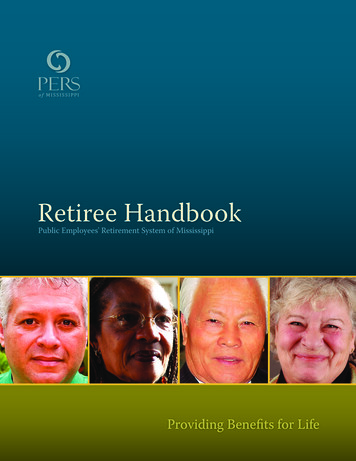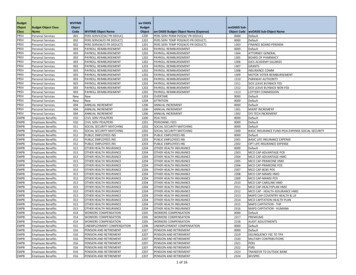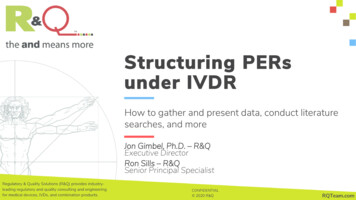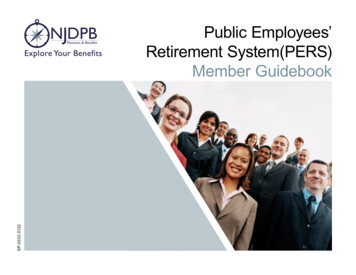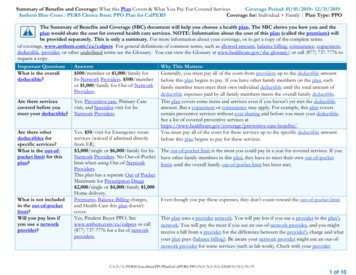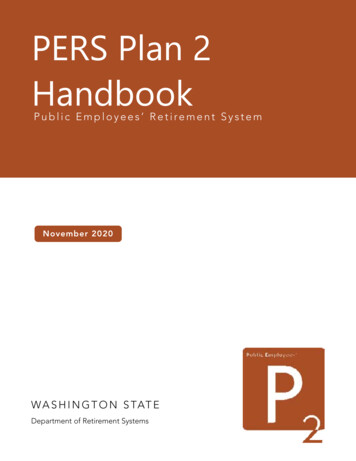
Transcription
PERS Plan 2HandbookPublic Employees’ Retirement SystemNovember 2020W A S H I N G T O N S TAT EDepartment of Retirement Systems
Public Employees’ Retirement System (PERS) — Plan 2Welcome to PERSMilestones/life changesApproachingretirementReady to retireOnce you retire23346PERS Plan 2 summaryHow to contact the Department of Retirement SystemsPrivacy of your informationHow your plan worksPlanning for retirement777888Becoming vestedOption to transfer to PERS Plan 3Leaving public serviceReturning to public serviceMarriage or divorceIf the unexpected happens101011111212Retirement planning checkupService retirementEarly retirementRetiring as a dual memberEstimating your benefitAnnuity options1313131314141414Applying for retirement onlineApplying for retirement on paperYour benefit optionsHealth insurance coverageFederal benefit limitFederal tax on your monthly benefitLegal actionsWhen and how your benefit will be paid15151515Cost-of-Living Adjustment (COLA)Working after retirementBenefit overpayments and underpaymentsChanging a benefit option or survivor after you retire1617Glossary of termsIndex
Welcome to the Public Employees’ Retirement SystemPERS Plan 2 summaryPERS Plan 2 is a defined benefit plan.You are eligible to retire with a fullbenefit at age 65 if you have at least fiveyears of service credit.When you meet plan requirements andretire, you are guaranteed a monthlybenefit for the rest of your life.Retirement before 65 is considered anearly retirement. If you have at least20 years of service credit and are 55 orolder, you can choose to retire early, butyour benefit might be reduced. There isless of a reduction if you have 30 or moreyears of service credit.Your monthly benefit will be basedon your earned service credit andcompensation while a member of PERSPlan 2.This formula will be used to calculate yourmonthly benefit:2% x service credit years x AverageFinal Compensation monthlybenefitIf the unexpected happens — disabilityor death before retirement — a benefitmight be available.If you become totally incapacitated andleave your job as a result, you might beeligible for a disability retirement benefit.You and your employer each contributea percentage of your salary or wages tohelp fund the plan.The Pension Funding Council adoptscontribution rates and periodically adjuststhem to reflect the overall cost of theplan. The Legislature has the final decisionon contribution rates.If you die before you retire, your spouse,registered domestic partner or minorchild, if applicable, could be eligible toreceive a benefit based on your years ofservice credit.You are vested in the plan when youhave five years of service credit.Log in to or sign up for online access toyour retirement account.Once you are vested, you have earnedthe right to a future monthly benefit. Ifyou leave your job and withdraw yourcontributions, however, you give up yourright to a benefit.drs.wa.govTrack your contributions and servicecredit. Read the latest newsletter. Updateyour beneficiary information or emailaddress. Use your individual data toestimate your monthly benefit. And whenyou’re ready, apply for retirement. Youdrs.wa.gov/oaa.can get started at drs.wa.gov/oaa2
How to contact the Department of Retirement SystemsThe Washington State Department of Retirement Systems (DRS) administers the Public Employees’Retirement System and the Deferred Compensation Program (DCP).To contact DRSTo contact DCPPrivacy of your informationWe are committed to protecting the privacy of your personal account information,including your Social Security number, which we use to track your account and submitrequired reports to the IRS. We will not disclose your information to anyone unless weare required to do so by law.If you have insurance coverage through the Washington State Health Care Authority(PEBB or SEBB for example), we could share your information with HCA to better serveyou.Handbook summaryThis handbook is not a complete description of your retirement benefit. Stateretirement laws govern your benefit. If any conflicts exist between the informationshown in this handbook and what is contained in current law, the law governs.3GlossaryTermshighlightedin bold printappear inthe glossaryof terms onpage 16.
How your plan works You provide professional services on afee, retainer or contract basis and theincome you receive from those servicesis less than 50% of your gross income forwork performed in that profession. You are enrolled in a state-approvedapprenticeship program, employed toearn hours for completing the program,and making contributions to a unionsponsored or Taft-Hartley retirementplan.OverviewPERS Plan 2 is a 401(a) defined benefit plan.When you retire, you will receive a monthlybenefit for the rest of your life that is based onyour earned service credit and your AverageFinal Compensation (AFC). Even though thecontributions you make help to fund the planoverall, they do not factor into the monthlybenefit you receive.Membership in PERS Plan 2Membership in PERS might be optional forsome elected or appointed officials; employeesof the Legislature; city managers; and chiefadministrative officers of city, county, port andpublic utility districts. If you think you mightfall into this category, consider visiting the DRSElected or Governor-Appointed Official page.In general, you are automatically a memberof PERS if you are hired into an eligibleposition. A PERS-eligible position is normallycompensated for at least 70 hours of work permonth for at least five months of each year andthe employer is one of the following: State government (for example, agency,department, board or commission) Local government, including a city, townor county Public utility district Public institution of higher learning Housing authority Diking, fire, health, irrigation, park, library,port, reclamation, sewer or water district AirportPrevious membership in another Washingtonstate public service retirement systemMembership in another of Washington’s publicservice retirement systems (including thecity retirement systems of Seattle, Tacoma orSpokane) can affect your: Eligibility for PERS Plan 2 membership Eligibility to retire Benefit calculationEnrollment in your specific PERS plan (Plan 2or Plan 3) depends on additional conditions,including your hire date and the plan youchose at the time you first went to work for aDRS-covered employer.If you have ever been a member in anotherof Washington’s public service plans, it isimportant that you contact us to confirmyour eligibility and discuss your retirementoptions.Some employees might satisfy the basicmembership criteria but be ineligible for otherreasons. If one of the following applies to you,please contact us to determine whether you’reeligible for PERS: You are a member of, or have retiredfrom, another public retirement system inWashington state. You work for a college or university andbelong to that entity’s retirement plan. You signed a student waiver whileemployed by a college or university. You work for the city of Seattle, Spokaneor Tacoma, or you are an elected orappointed official of one of these cities.drs.wa.govContributing to the planYou are required to contribute a percentage ofyour salary or wages to your retirement plan.This includes overtime and tax-deferred wages,but it doesn’t include severance pay or cashpayments for unused sick or vacation leave. Ifyou have questions about the compensationyour employer reports for you, please contactyour employer.Your employer’s contributions are also basedon a percentage of your salary or wages.They are not matching funds, and you cannotwithdraw them if you leave public service.4
When you retire, the monthly benefit youreceive will have been funded over timeby your contributions, your employer’scontributions and investment earnings. ThePension Funding Council adopts contributionrates and periodically adjusts them to reflectthe overall cost of the plan. The Legislature hasthe final decision on contribution rates.Membership and How Does ItAffect Me? publication. You’re an employee of the WashingtonState School for the Blind, the Center forChildhood Deafness and Hearing Loss, oran institution of higher learning:» If you begin working in Septemberin an eligible position and earncompensation during at least ninemonths of the school year, you canreceive 12 service credit monthsfor the school year if you arecompensated for at least 810 hoursof employment. Six service creditmonths can be awarded if you startin September and are compensatedfor at least 630 hours but fewerthan 810 hours during the schoolyear.» If you earn compensation in fewerthan nine months of the schoolyear, you will receive service creditbased on the number of hours youare compensated for each month.Federal law limits the amount of compensationyou can pay retirement system contributionson and that can be used in your benefitcalculation. The amount can be adjusted eachlimit If you reachyear (see the current IRS limit).the limit in any calendar year, you don’t paycontributions for the remainder of the year andany salary earned over that amount isn’t usedin your pension calculation.Earning service creditService credit is based on the number ofhours you work, which your employer reportsto DRS. When you retire, your service credit is apart of your monthly benefit calculation.Designating your beneficiaryYou receive one service credit month for eachcalendar month in which you are compensatedfor 90 or more hours of work. No more thanone month of service credit can be earnedeach calendar month, even if more than oneemployer is reporting hours you work.The beneficiary information you give DRStells us the person(s) you want to receive yourremaining benefit, if any, after your death.You can submit or update your beneficiaryinformation at any time before retirement inaccount Sign up for oryour online retirement account.log in to your account. Then select My Account View/Edit (beside Beneficiary). You havethe option of submitting a paper BeneficiaryDesignation form instead, if you prefer.You receive one-half of a service credit if youwork fewer than 90 hours but at least 70 hoursin a calendar month. You receive one-quarterof a service credit if you are compensated forfewer than 70 hours in a calendar month.If you don’t submit this information, anybenefits due will be paid to your survivingspouse or minor child. If you don’t have asurviving spouse or minor child, we will payyour estate.If one or both of the following apply to you,you need to know additional service creditinformation: You’re an employee who has previousmembership in another Washington statepublic retirement system:» If you have earned service creditin another of the state’s publicretirement systems, you might beable to combine your PERS servicecredit with credit you earned inthe other system(s). For moreinformation, read the What Is DualBe sure to review your beneficiary designationperiodically and update it in your onlineretirement account if you need to make achange. If you marry, divorce or have anothersignificant change in your life, be sure toupdate your beneficiary designation becausethese life events might invalidate your previouschoices.5
State-registered domestic partners, accordingto RCW 26.60.010, have the same survivor anddeath benefits as married spouses. Contact theSecretary of State’s Office if you have questionsabout domestic partnerships.your benefit:2% x service credit years x AFC monthly benefitAverage Final Compensation (AFC) is theaverage of your 60 consecutive highest paidservice credit months. Any severance pay orlump sum payment for unused sick leave orvacation/annual leave is not included.When you will be vestedOnce you have at least five years of servicecredit in PERS, you have a vested right to aretirement benefit.ExampleUsing the formulaIf you leave PERS employment before you’reeligible to retire, you can choose to either leaveyour contributions in the plan, where they willcontinue to earn interest, or you can withdrawyour contributions.If you retire at age 65 with 32 years ofservice credit and a monthly Average FinalCompensation of 5,000, your monthlybenefit is 3,200, calculated as follows:2% x 32 x 5,000 3,200If you decide to withdraw your contributions,you give up your right to a future PERSretirement benefit. See “Returning to publicservice” on page 8 for more about reestablishing your benefit rights in certaincircumstances.Planning for retirementWhen you will be eligible to retireEven though retirement might seem far away,planning for it now is one of the best thingsyou can do for yourself and your family. Yourmonthly benefit will be an important partof your income in retirement, but it is just aportion of what you will need.You are eligible to retire at age 65 if you haveat least five years of service credit.Options to retire earlier are available (see“Early retirement” on page 11), but yourbenefit will be reduced to reflect that youwill be receiving it over a longer period oftime. Hired on or before April 30, 2013: Toretire early, you must be at least 55 andhave 20 or more years of service credit.There is less of a benefit reduction forearly retirement if you have 30 or moreyears of service credit. Hired on or after May 1, 2013: To retireearly, you must be at least 55 and have 20or more years of service credit. If you areat least age 55 with 30 or more years ofservice credit, your benefit reduction willbe 5% for each year (prorated monthly)before you turn age 65.How do you begin developing your personalplan for retirement? First, estimate how muchmoney you will need. That can vary based onfactors that include: The lifestyle you’ll want to lead when youretire Your health Whether you’ll carry any debt intoretirement Your life expectancyNext, estimate how much money you willreceive from all sources, such as Social Security,personal savings and other employer pensionplans. When you compare this number withwhat you think you will need, you can adjustyour savings plan accordingly.How your monthly benefit will be calculatedYour benefit is determined by your servicecredit years and compensation. When youretire, this formula will be used to calculatedrs.wa.gov6
Milestones/life changesMany tools can help you with your planning.websiteHere are some on the DRS website: Live webinars are available to attendonline. Topics include Plan 2, Plan 3,plan choice, the Deferred CompensationProgram (DCP), distributions from Plan3, investment basics and Social Securitybasics. Retirement seminars are available toattend in person. You can also watchseminars when it’s convenient for you onthe DRS Retirement Seminars webpage.Topics include Plan 1, Plan 2, Plan 3, DCP,Social Security and health care options,and the Voluntary Employees’ BeneficiaryAssociation (VEBA). The benefit estimator within your onlineaccount can calculate your monthlybenefit based on a variety of scenarios(for example, different retirement dates)using your actual account data. If youhaven’t already registered for this service,it takes just a few minutes to do so. The Deferred Compensation Program(DCP) is a special type of savings programthat helps you invest for the retirementlifestyle you want to achieve. Unliketraditional savings accounts, DCP istax-deferred. That means it lowers yourtaxable income while you are workingand it delays payments of income onyour investments until you withdraw yourfunds. Contributions are automaticallydeducted from your paycheck, so savingis easy. You can start with as little as 30 per month. You can also let yourcontributions grow with percentagedeductions.Becoming vestedWhen you have at least five years of servicecredit in PERS Plan 2, you have a vested rightto a retirement benefit. This is a significantmilestone in your public service career.Option to transfer to PERS Plan 3If you became a member of PERS Plan 2 beforePlan 3 began (that is, March 1, 2002, for stateand higher education employees and Sept. 1,2002, for local government employees), youhave an opportunity each January, while youare employed, to transfer to Plan 3. Plan 3 hastwo parts — a defined benefit and a definedcontribution — and is referred to as a “hybridplan.”If you decide to transfer, your Plan 2contributions plus any interest they haveearned will be moved to a Plan 3 definedcontribution account. If you transfer to Plan 3,you cannot return to Plan 2.Making a retirement plan choice is anindividual decision. Your decision should bebased on your personal situation. For moreinformation, visit the Plan Choice section or seewebsitethe Plan 3 website.Leaving public serviceIf you leave PERS employment, you can chooseto either leave your contributions in the planuntil you’re eligible to retire or withdrawthem. The IRS requires that you begin takingpayment of your monthly benefit no later thanage 72, unless you are still employed.Be sure to revisit your plan periodically andadjust for any changes in your professional andpersonal life.Leaving PERS-covered employment is the onlycircumstance in which you can withdraw yourcontributions. Doing so cancels any rights andbenefit you have accrued in PERS. You canrestore your contributions and re-establish7
Marriage or divorceyour benefit only in certain circumstances (seethe next section).Marrying, divorcing or separating can affectyour monthly benefit.There are tax implications to withdrawingyour contributions, so you might want tocontact the IRS or a tax advisor before makinga decision. The Withdrawal of RetirementContributions publication offers more detailedinformation.Court-ordered property divisionA court-ordered property division could affectyour benefit. As long as the order complieswith applicable laws, we will pay a monthlybenefit to your ex-spouse according tothe division. The DRS publication How Cana Property Division Affect My RetirementAccount? contains detailed information.Be sure to keep us up to date on any changesto your name, address or beneficiary. It’simportant that you keep your beneficiarydesignation current, because a divorce, marriageor other circumstance might invalidate it.Updating your beneficiaryThe beneficiary information you give DRStells us the person(s) you want to receive yourremaining benefit, if any, after your death.You can submit or update your beneficiaryinformation at any time before retirement inaccount Sign up foryour online retirement account.or log in to your account. Then select MyAccount View/Edit (beside Beneficiary).You have the option of submitting a paperBeneficiary Designation form instead, if youprefer.Returning to public serviceIf you leave your position, withdraw yourcontributions and later return to PERS work,you might be able to restore your previousservice credit. To do so, you must repay thetotal amount of the contributions you withdrewplus interest within five years of returning towork or before you retire, whichever comesfirst. Contact us to find out that amount.If you marry or divorce before you retire, youneed to update your beneficiary information,even if your beneficiary remains the same. It’svery important that you keep your beneficiarydesignation up to date.A dual member, or someone who belongsto more than one retirement system, mightbe able to restore service credit earned in aretirement system other than PERS. Each timeyou become a dual member, you’ll have 24months to restore service credit earned in aprevious retirement system.If the unexpected happensTemporary leave from your jobIt might still be possible to purchase servicecredit after the deadline has passed. However,the cost in that case is considerably higher. Toexplore financial projections and comparisonsof your estimated retirement benefits, try usingCalculatorour Plan Choice Calculator.You might need to take a temporary leavefrom your job because of: Military service An authorized leave of absence A temporary disabilityIf so, you might be able to obtain serv
drs.wa.gov 2 PERS Plan 2 summary PERS Plan 2 is a defined benefit plan. When you meet plan requirements and retire, you ar
